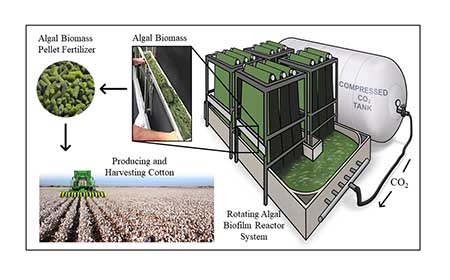Better Biofertilizer through Algae
February 6, 2023
By Dennis Spellman
HOUSTON - Three University of Houston professors are testing a process to create environmentally friendly biofertilizer for crops by using algae to capture carbon dioxide.
The study is being funded by a $400,000 Department of Energy grant.
“It is anticipated the algal biomass biofertilizer will help reduce chemical fertilizer use and increase soil organic carbon,” Professor Venkatesh Balan of the College of Technology’s Engineering Technology Department said. “Overusing chemical fertilizers can contribute to soil acidification and can harm growing properties”
The study will test a process that, if successful, will create three benefits for the environment: remove nutrients in wastewater to suppress algae bloom in waterways; reduce environmental pollutant carbon dioxide; and produce an environmentally friendly biofertilizer.

Khan and Professors Venkatesh Balan of the Engineering Technology Department, and Professor Xiaonan Shan from the College’s Electrical Engineering Department are using algae grown in wastewater to capture carbon dioxide. Microalgae's ability to absorb large amounts of carbon dioxide has led them to investigate a process that captures carbon dioxide and uses it to improve the environment.
They are collaborating with Prairie View A&M on the study
"One of the biggest threats facing humanity is global warming caused by greenhouse gas emissions such as carbon dioxide, methane, nitrous oxides, hydrochlorofluorocarbons, hydrofluorocarbons, and molecular hydrogen," Balan said.
Algae will not only absorb carbon dioxide, but also capture nitrogen, phosphorous and potassium from wastewater. Because those elements make up a complete biofertilizer for plants, Balan and Khan are testing a system that produces an eco-friendly fertilizer by submerging a cylinder wrapped in a biofilm into wastewater to grow and harvest the algae.
"Algae growth conditions will be optimized using a bench top Revolving Algal Biofilm (RAB) operated by revolving biofilm on a cylinder reactor system partially submerged in wastewater in the lab," Balan said.
Microalgae are grown on the revolving biofilm and then scraped off and processed into pellets. The pellets act as fertilizer and will be tested on cotton plants in trials that will last for two consecutive years.
"Average microalgae yield is 1.65 tons per million gallons of wastewater per year using the RAB pilot system. However, there is potential to increase the yield to 5 tons per million gallons of wastewater by bubbling carbon dioxide," Shan said.
There may also be other benefits. It's believed that using biomass fertilizers instead of chemical fertilizers will reduce root-knot nematode, a condition that kills crops. Khan says it will also alleviate drought stress on cotton plants, improve nutrient and carbon uptake, and increase farmers' productivity. Removing nitrates and phosphates in wastewater also reduces dangerous toxins that can leach into waterways and kill fish and aquatic life.